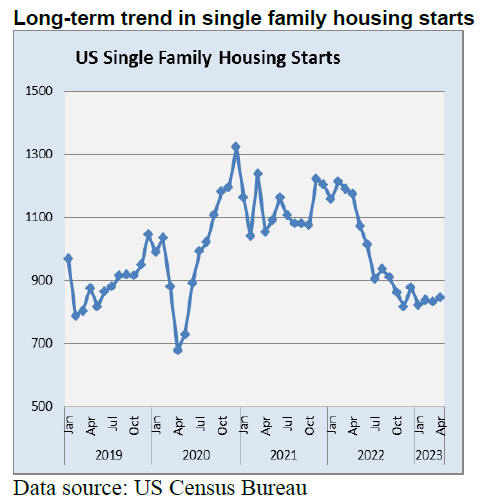|
Report from
North America
May housing starts encouraging
A press release for the US Census Bureau has reported
privately‐owned housing units authorised through building permits in May
were at a seasonally adjusted annual rate of 1,491,000. This is 5.2%
above the revised April rate of 1,417,000, but is 12.7% below the May
2022 rate of 1,708,000 units.
Single‐family authorisations in May were at a rate of 897,000; this is
4.8% above the revised April figure of 856,000. Authorisations of units
in buildings with five units or more were at a rate of 542,000 in May.
Housing starts in May were at a seasonally adjusted annual rate of
1,631,000. This is 21.7% above the revised April estimate of 1,340,000
and is 5.7 % above the May 2022 rate of 1,543,000.
Single‐family housing starts in May were at a rate of 997,000; this is
18.5 % above the revised April figure of 841,000. Housing completionsin
May were at a seasonally adjusted annual rate of 1,518,000. This is 9.5%
above the revised April estimate of 1,386,000 and is 5.0% above the May
2022 rate of 1,446,000.
Single‐family housing completions in May were at a rate of
1,009,000.This is 3.9% above the revised April rate of 971,000. Keen
interest from would-be home buyers is creating strong demand for new
homes. These buyers continue to face a lack of options in the resale
market. This is the second month in a row that starts are up. The pace
of construction was the highest since last April, when starts hit a 1.8
million pace. The surge in construction this spring was led by the
Midwest.

See: https://www.census.gov/construction/nrc/current/index.html
The Canadian housing market has gained strength since March of
this year and analysts anticipate the impact of these recent gains on
affordability to last for some time. Housing demand is particularly
strong in Canada as surging population growth, a tight labour market and
accumulated pandemic-era savings are driving demand according to a
Desjardins report.
However steam has been taken out of the market as the the Bank of Canada
raised its key interest rate on 7 June 7 and this has put downward
pressure on home prices which had rebounded faster than the Bank had
expected.
See:
https://www.mpamag.com/ca/mortgage-industry/market-updates/housing-market-recovery-likely-to-negatively-impact-affordability-desjardins/451017
In related news, US existing-home sales increased in May according to
the National Association of REALTORS. Sales were mixed among the four
major US regions with the South and West posting improvements and the
Northeast and Midwest experiencing pullbacks. All four regions
experienced year-over-year decline in sales.
New homes are selling at a pace as in pre-pandemic times because of
abundant inventory in that sector. However, existing home sales activity
is down as the inventory is roughly half the level of 2019.
Total existing-home sales1 – completed transactions that include
single-family homes, townhomes, condominiums and co-ops – rose 0.2% from
April to a seasonally adjusted annual.
See:
https://www.bls.gov/news.release/empsit.nr0.htm
Receding inflation worries lifts consumer sentiment
US consumer sentiment continued to improve through to the end
of June while short-term inflation expectations were at a two-year low.
The University of Michigan consumer sentiment survey for June showed a
9% surge in overall sentiment and an even stronger surge in expectations
for the future. Receding inflation worries are the main driver of this
change.
Consumer sentiment rose 9% in June across all demographic groups this
striking upswing reflects a recovery in attitudes generated by the
resolution of the debt ceiling crisis along with more positive feelings
over softening inflation.
Views of their own personal financial situation were unchanged, however,
as persistent high prices and expenses continued to weigh on consumers.
There are signs June was a turning point in consumer’s gloomy views of
the economic situation.
See:
https://www.axios.com/2023/06/30/us-consumer-sentiment-surge
and
http://www.sca.isr.umich.edu/
|